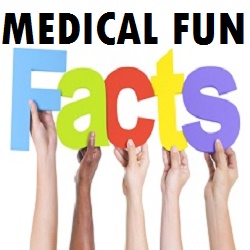 Interesting Medical Facts to Know
Interesting Medical Facts to Know
Q. What is a normal blood pressure value?
A. 120/80
Q. What is the top number called in you blood pressure?
A. Systolic
Q. What is the bottom number called?
A. Diastolic
Q. What is more concerning to have, an elevate systolic value (top number), or an elevated diastolic value? (bottom number)
A. Diastolic elevation is a bigger concern.
Q. What is BMI?
A. Body Mass Index
Q. How do you calculate your target heart rate?
A. 220 – your age = target heart rate
Q. How much sleep should an adult average per night?
A. 8 to 9 hours
Q. How many calories make up a pound?
A. 3,500
Q. How many calories do you have to eat less per day to lose a pound per week?
A. 500
Q. Approximately how many calories do you burn when you run an 8 minute mile?
A. 120 calories
Q. Approximately how many calories are in a piece of whole wheat bread?
A. 130 calories
Q. What percentage of weight loss is through exercise and what percentage is through nutrition?
A. 20 percent exercise and 80 percent nutrition
Q. What does GMO mean?
A. Genetically Modified Organisms
Q. What does Genetically Modified Organisms mean?
A. This term is used to describe the food that has been genetically altered in a lab to change the organism.
Q. How many bones are in your cervical spine?
A. 7
Q. How many bones are in your thoracic spine?
A. 12
Q. How many are in your lumbar spine?
A. 5-6
Q. Which fruit has the the most carbs: Raspberries, blueberries or watermelon?
A. Watermelon
Q. What is a glycemic index?
A. A measure of how much insulin gets released in your blood stream after eating certain foods. Typically a measurement of simple carbohydrates.
Q. What has a higher glycemic index: Sugar or wheat?
A. Wheat’s glycemic index is 74 and sugar is 59.
Q. Who tends to live longer: Men or women?
A. Women
Q. What does cage-free eggs mean and does that mean the eggs are organic?
A. Cage-free chickens are allowed to run around outside and eat things from the ground. It does not mean they are organic.
Q. What does organic mean?
A. A crop or animal grown or raised without chemicals placed in their food or fertilizer.
Q. What has less fat, chicken breast or chicken thighs?
A. Chicken breast
Q. Which 2 fruits have the lowest glycemic index: Watermelons, green apples, pineapples or blueberries?
A. Green apples and blueberries
Q. Which gender tends to lose weight faster: Men or women?
A. Men
Q. Who typically has a lower body fat: Men or women?
A. Men
Q. When is the best time to check and determine your resting heart rate?
A. Before you get of bed in the morning.
Q. What is gluten?
A. Gluten is a general name for the proteins found in wheat, rye, barley and triticale. It helps foods maintain their shape, acting as a glue that holds food together.
Q. What is gluten free?
A. Food that contains no gluten.
Q. What foods contain gluten?
A. Beer, wheat bread, rice, strawberries, chocolate cake and chick peas.
Q. How much protein should you eat per day?
A. On average around 60 grams. It is weight based. Typically 1 gram of protein per kilogram of body weight (1 kilogram equals 2.2 pounds). If you weigh 70 kilograms, you should eat about 70 grams of protein per day.
Q. How many grams of fiber should you have per day?
A. 25 grams
Q. What is fiber’s primarily function?
A. Fiber makes your gastrointestinal system more regular and supports optimal gastrointestinal health. It also helps to support blood glucose levels and makes you feel full.
Q. Who typically has the lowest body fat by race and gender?
A. Caucasian males
Q. How many types of diabetes are there?
A. 2 types: type 1 and type 2
Q. What is difference between type 1 and type 2 diabetes?
A. Type 1 is where the pancreas no longer makes insulin and is associate with onset at a young age and normal body weight. This condition is regulated with insulin. Insulin needs to be injected and cannot be taken as a pill. Type 1 diabetes is not reversible.
Type 2 diabetes is where the body becomes resistance to insulin. It is associated with an onset at an older age in overweight people. Treatment consists of weight loss and/or oral medication. Only in really extreme cases is type 2 diabetes treated with insulin. Type 2 diabetes can be reversed.
Q. What is Celiac’s Disease?
A. Celiac disease is a problem some people have with foods that contain gluten. Gluten is a type of protein. It’s found in the grains wheat, barley, rye, and triticale (a wheat-rye cross). When you eat gluten, it triggers an immune response that cause damage to the small intestines. There is typically abdominal pain and poor absorption of food associated with this condition. The treatment is to avoid foods with gluten.
Q. What does vegan mean?
A. Living a vegan lifestyle means consuming plant based product with no animal derived ingredients.
Q. What can you do to eliminate or reduce common allergens and non-healthy ingredients from your food?
A. Eliminate or reduce wheat/ gluten, dairy, refined sugar, alcohol, soy and corn from your diet.
Q. When is the best time to stop eating during the day?
A. It is best to eat all meals before 7 p.m.
Q. What should your plate look like in reference to food percentages?
A. 1/2 of the plate should have vegetables: Kale, chard, mustard greens, broccoli or asparagus.
1/4 of your plate should have lean protein: Legumes, lentils, and if you eat meat: Wild fish, nature or organic chicken or turkey.
1/8 of your plate should have complex carbs: Brown rice, quinoa, beets, sweet potatoes, carrots or millet.
1/8 of your plate should have good fats: Seeds, nuts, nut butters, nut oils, avocado, coconut oil and flax seed oil.
Q. Healthy living recommendations are to remove: Pasta, white rice, bread and cereal. What are good items to replaces the above foods?
A. Good replacement foods are: Brown rice, quinoa, brown rice pasta and spaghetti squash.
Q. Healthy living recommendations are to remove: Milk, cheese, yogurt and butter. What are good replacement foods?
A. Good replacement foods are: Almond milk, rice milk, coconut milk and nutritional yeast.
Q. Healthy living recommendations are to remove: Boxed and packaged food, pre-manufactured food, fast food and frozen dinners. What are good replacement foods?
A. Good replacement foods are: Locally grown, seasonally available fruits and vegetables, free range and hormone-free meats.
Q. Why is it important to stay hydrated?
A. Water is critical for optimal physiologic function and healthy living. Water helps to process nutrients and maintaining proper fluid balances.
Q. How much water should you drink per day?
A. A good rule of thumb is to drink half your body weight ( in ounces ) per day. For example if you weight 120 pounds you should drink 60 ounces of water.
Q. Why is it important to eat your food slowly?
A. It takes time to tell your brain that your stomach is full. If you eat fast, you may overeat because you still feel hungry when all your food is gone and off your plate. Slow down so the brain has time to register that you are full. Plus, eating slowly will help support better digestion.
Q. What is a quick way to measure a high intensity workout?
A. A quick way to determine if you are doing a high intensity workout is the inability to be able to talk comfortably while exercising.
Q. What are the benefits of plant based protein vs. an animal based protein?
A. Peas and rice together, deliver a 100% amino score. Plant based protein is easier on the stomach than animal based proteins. Pea and rice protein is not a common allergen, like many animal based proteins.
Q. What are some of the highest Genetically Modified Organisms?
A. Soy, corn and wheat
Q. What are two reasons to avoid dairy products?
A. Dairy cows may have been given antibiotics and hormones which can be transferred into the cow milk or beef. They also have a high fat content.
Q. How many calories are in a gram of protein?
A. 4
Q. How many calories are in a gram of carbohydrates?
A. 4
Q. How many calories are in a gram of fat?
A. 9
Q. What is the definition of Basal Metabolic Rate (BMR)?
A. The amount of calories needed to run your body’s basic functions at rest. This number changes throughout your life.
Q. What is an essential nutrient?
A. A nutrient that cannot be made by the body. An example is an Omega 3 fatty acid. They are polyunsaturated fatty acids.
Q. What are some examples of sources of Omega 3 fatty acids?
A. Plant: Flax seed, sunflower seeds, kiwi and raspberry seeds
Animal: Fish and krill
Q. What is the function of Omega 3 essential fatty acids?
A. It supports brain function, eye health and cognitive health.
Q. How many amino acids are essential?
A. Nine : phenylalanine, valine, threonine, tryptophan , methionine , leucine, isoleucine, lysine, and histidine.
Q. What is an essential amino acid?
A. An amino acid that cannot be made or synthesized by the body. They must be supplemented/supplied in our diet.
Q. What is an amino acid?
A. Amino acids are organic compounds that combine to form proteins. When amino acids join together in chains they form proteins.
Q. How many amino acids are there?
A. 22
Q. Why do we need protein in our diet?
A. Proteins are the main building blocks of the body. They’re used to make muscles, tendons, organs and skin. Proteins are also used to make enzymes, hormones, neurotransmitters and various tiny molecules that serve important functions. Without protein, life as we know it would not be possible.


 A hot topic in ACL research involves which is a more superior operation: double bundle ACL reconstructions versus the single bundle ACL. In the April 2014 Journal of Bone and Joint Surgery Drs. Starman et al. reported on this topic in the "What's New in Sports Medicine" section of the journal. They stated that there is no current evidence to support one procedure over the other.
A hot topic in ACL research involves which is a more superior operation: double bundle ACL reconstructions versus the single bundle ACL. In the April 2014 Journal of Bone and Joint Surgery Drs. Starman et al. reported on this topic in the "What's New in Sports Medicine" section of the journal. They stated that there is no current evidence to support one procedure over the other.
